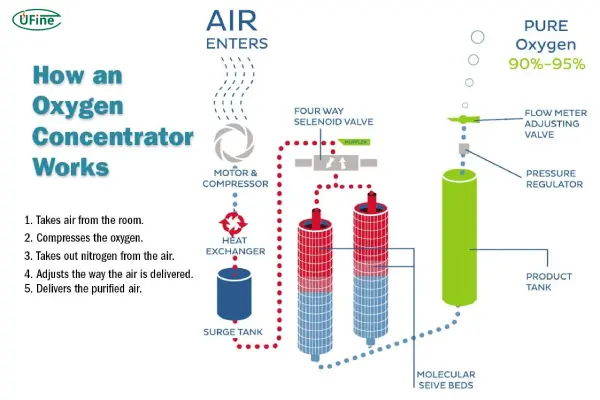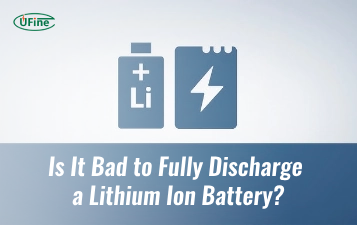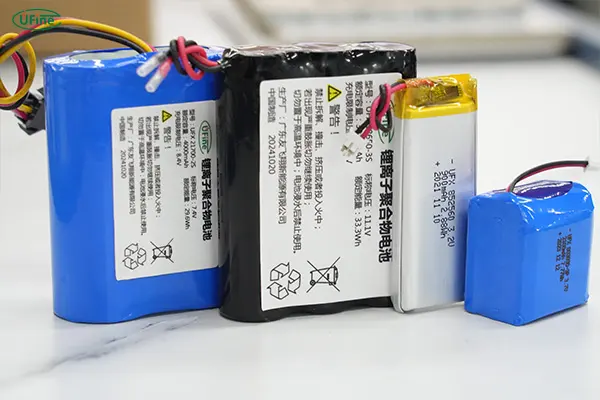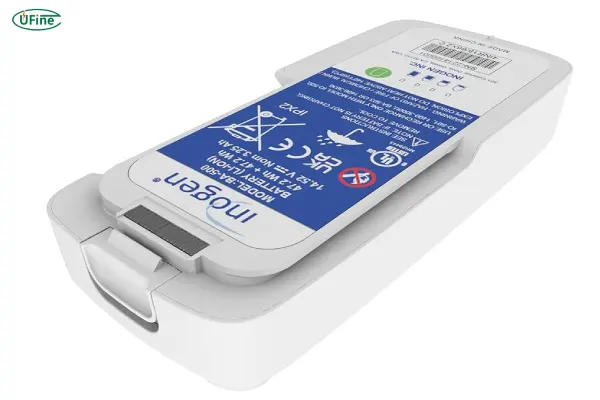
- Part 1. How portable oxygen concentrators work?
- Part 2. Types of oxygen concentrator batteries
- Part 3. Key features of a high-quality oxygen concentrator battery
- Part 4. Rechargeable lithium battery for oxygen concentrator
- Part 5. Best battery backup for oxygen concentrator
- Part 6. Oxygen concentrator battery price
- Part 7. Portable oxygen concentrator battery life
- Part 8. Battery charger for portable oxygen concentrator
- Part 9. Charging & maintenance tips for longevity
- Part 10. How to choose the right oxygen concentrator battery
- Part 11. Custom battery solutions for oxygen concentrator manufacturers
- Part 12. Final thoughts
- Part 13. FAQs
Part 1. How portable oxygen concentrators work?
Imagine the moment you breathe easier—away from hospital walls, feeling the breeze, free to walk, travel, or just sit in the garden. That’s the power of a portable oxygen concentrator, and it all depends on its battery.

Here’s how these amazing devices work:
- Air intake: Your POC draws in room air.
- Filtration: Nitrogen is removed, leaving purified oxygen.
- Delivery: An air compressor pumps oxygen through nasal cannulas.
- Battery power: Without it, the unit is dead.
The battery may seem invisible, but it’s the heart that keeps your freedom beating. When choosing a portable oxygen concentrator battery, you’re choosing peace of mind to live on your terms.
Part 2. Types of oxygen concentrator batteries
Not all oxygen concentrator batteries are the same. Each type suits different needs:
Internal (built-in)
Compact and convenient. Users don’t see them, but they limit battery life and need full-device replacement.
External/removable batteries
Let you swap and charge separately, reducing downtime. Great for daily use.
Modular multi-cell packs
Systems like Inogen offer 8-cell or 16-cell options—double runtime for twice the weight.
Emergency backup batteries
Stand-alone units that support POCs via AC/DC or solar inputs.
Each type suits different users: whether you need light and small for short errands or big and bold for full-day outings.
Part 3. Key features of a high-quality oxygen concentrator battery
Choosing a battery is more than just capacity. Focus on these essential features:
Runtime
Single batteries typically deliver 3–7 hours; extended packs double that capacity
Rechargeability
Lithium-ion (Li-ion) and lithium-polymer (Li-Po) dominate—lightweight, reliable, and long-lasting.
Weight vs. power
Extended batteries add weight. That added pound is worth it—if it keeps you free to roam.
Safety certifications
Look for UN38.3, IEC 62133, and FAA/TSA approval—especially for travel.
Built-in protection
Thermal, overcharge, and short-circuit protection prevent hazards.
User-friendly design
Easy battery swaps, clear LED indicators, and robust connectors mean stress-free use.
A truly great oxygen concentrator battery is safe, certified, convenient, and long-lasting.
Part 4. Rechargeable lithium battery for oxygen concentrator
Most POCs use Li-ion or Li-Po batteries, but what makes them special?
- High energy density: More power in less space.
- Cycle longevity: Good batteries maintain ~70–80% capacity over 300–500 cycles
- Form flexibility: Li-Po can be ultra-thin or high-rate.
This is where Ufine Battery shines. We’re a Chinese custom lithium battery manufacturer offering Li-Po, LiFePO₄, and 18650 types. Whether you need ultra-thin, high-temperature, or high-discharge batteries, Ufine delivers tailor-made solutions—just tell them your voltage, capacity, and size needs.
So if your POC’s standard battery doesn’t cut it, Ufine can craft a perfect match. Contact us now!
Part 5. Best battery backup for oxygen concentrator
Traveling with oxygen is emotional—closing the door on your home, unsure of your power supply. Yet you need confidence that your concentrator won’t fade mid-journey.
Top backup strategies include:
1. Double/extended batteries
Inogen G5’s 16-cell unit weighs just 2 lbs and gives up to 13 hours runtime
2. Dual battery systems
Some POCs let you hot-swap batteries, reducing downtime to zero.
3. Portable power stations
A 500–1000 Wh station can run both your POC and charge other medical devices—most are compact and reliable .
Vehicle and solar charging kits
4. Ideal for outings or camping.
Choosing backup that suits your emotional comfort is just as important as technical specs. After all, peace of mind is priceless.
Part 6. Oxygen concentrator battery price
Cost is real. Avoid sticker shock by knowing typical prices:
- Standard batteries: $200–$400
- Example: Inogen G5 battery (~6 hr) costs around $407
- Extended batteries: $300–$600
- Inogen G5 16-cell is listed at $314.99–$618 depending on vendor
- Backup power stations: $400–$1000
OEM batteries cost more but guarantee compatibility. Aftermarket units can start from $50, but quality varies—opt for certified brands only.
Tip: Calculate cost per hour of runtime—sometimes a slightly larger battery saves money in the long run.
Part 7. Portable oxygen concentrator battery life
In reality, battery life fluctuates. It depends on flow settings, battery size, and environment.
1.Flow setting
Higher settings drain faster. For example:
- G5 at setting 1 (8-cell): ~6.5 hrs
- At setting 2: ~5 hrs
- Double batteries double these runtimes
See this breakdown from G5:
| Setting | 8-cell | 16-cell |
|---|---|---|
| 1 | 6.5 hr | 13 hr |
| 2 | 5.0 hr | 10 hr |
| 3 | 3.5 hr | 7 hr |
| 4 | 2.5 hr | 4.9 hr |
| 5 | 1.9 hr | 3.8 hr |
| 6 | 1.4 hr | 2.6 hr |
2. Age of battery
After ~300 cycles, expect ~70–80% capacity.
3. Environmental effects
Heat and cold distort capacity.
So if your life depends on mobility, track performance carefully—and plan backups.
Part 8. Battery charger for portable oxygen concentrator
Charging isn’t glamorous, yet it’s essential—and emotional—because it’s the bridge between freedom and dependence.
Three charger types:
AC wall chargers
Restore a single battery in about 4 hours; doubles take ~8 hours.
DC/car chargers
Let you charge while driving—turn trips into safe journeys.
External chargers
Charge batteries outside the unit so the POC can keep running.
Part 9. Charging & maintenance tips for longevity
Your battery is dependable only if cared for. Here’s a deeply human guide:
- Charge fully before first use.
- Avoid draining to zero—300 cycles in and it’s fragile.
- Store at 50–60% charge when unused.
- Recharge every 2–3 months if left idle .
- Avoid temperature extremes—hot cars kill batteries.
- Clean contacts gently with dry cloth.
- Calibrate monthly: run until empty, rest 1 hour, recharge fully, monitor performance.
- Inspect monthly for swelling or damage; replace if suspect.
These steps preserve lifespan and fuel your autonomy.
Part 10. How to choose the right oxygen concentrator battery
This choice isn’t just technical—it’s emotional. It’s about freedom, safety, and independence.
Ask yourself:
- How long do I need oxygen off-grid?
- Do I prefer light or long runtime?
- Will travel or altitude matter?
- Do I trust OEM vs. certified third-party?
- Is my budget tight or am I investing in peace of mind?
If subtle tweaks in size, capacity, or certifications might elevate your lifestyle, then consider custom battery solutions—like those from Ufine Battery. We can align your battery with your needs and future device plans.
Part 11. Custom battery solutions for oxygen concentrator manufacturers
Behind every new POC is a need for a high-performance battery. If you’re designing or updating medical equipment, Ufine Battery is ready to help:
- Custom form factors—thin, tall, round, flexible
- Precise voltage and capacity tuning
- Built-in safety circuits
- Smart features—Bluetooth, app integration
- Compliance: UL, IEC, UN38.3, FAA
From prototype to scale, Ufine supports OEMs with engineering collaboration, prototyping, testing, and certification—all from a single trusted source.
So, if you’re building the next generation of portable oxygen concentrators—or simply want a better battery than stock—connect with Ufine for reliable custom solutions.
Part 12. Final thoughts
Your oxygen concentrator battery does more than power a device—it powers your life. It gives you mornings with sunlight, evenings with friends, moments of independence and dignity. Choosing the right battery and caring for it wisely isn’t just technical—it’s deeply personal.
If you want batteries that match your story, needs, and future devices, get in touch with Ufine Battery. We craft custom lithium packs—from 18650 to Li-Po, small to ultra-thin, high-rate to high-temp—to precisely fit your specifications and safety expectations.
Part 13. FAQs
How long do standard POC batteries last?
About 3–7 hours per single battery; extended options last up to 13 hours.
Are POC batteries safe for air travel?
Yes—they’re FAA-approved. Carry backups totaling 150% of flight duration.
How often should I replace my battery?
Roughly every 2–3 years or after 300–500 cycles; replace sooner if runtime drops significantly .
Is it okay to use cheap replacement batteries?
Only if they carry full certifications (UN38.3, IEC, FAA). Cheaper batteries may not.
Can I store a battery at 100% charge?
Long-term storage at 50–60% is best; high charge stresses cells .
Related Tags:
More Articles

Is It Bad to Fully Discharge a Lithium Ion Battery?
Discover what happens if a lithium battery is fully discharged and how to safely recharge 12V batteries to prevent permanent damage.
Does a Higher mAh Battery Last Longer?
Does a higher mAh battery really last longer? Learn what mAh means, real battery life in hours, replacement safety (4000 vs 5000mAh), and real examples.
Exploring the Lithium Ion Battery Fire Temperature
Discover the lithium-ion battery fire temperature and learn how to stay safe. Get essential tips to prevent battery fires and protect your devices today.
The Ultimate Guide to 6s Lipo Batteries
A beginner-friendly guide to 6S LiPo batteries. Understand voltage, capacity, charging tips, safety rules, and real-world applications.
What is the NCMA battery? What is the difference between it and the NMC battery? Which one is better? This article will answer your questions.




